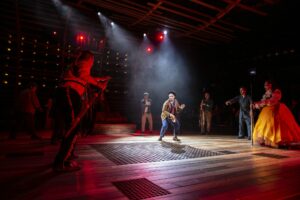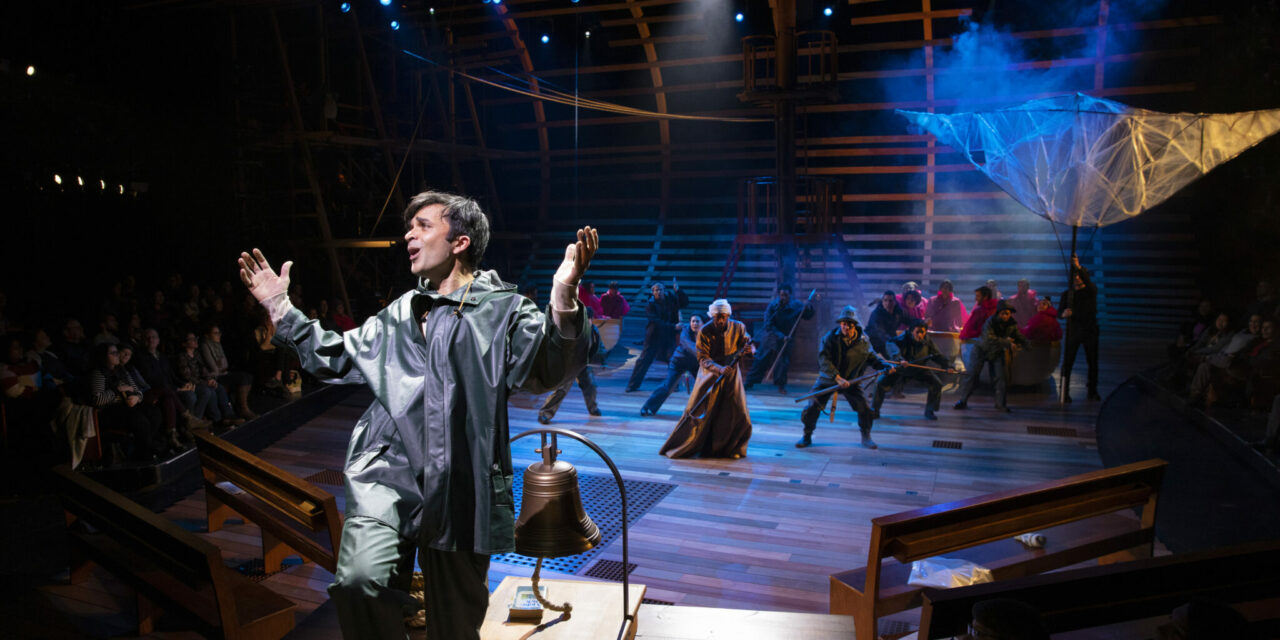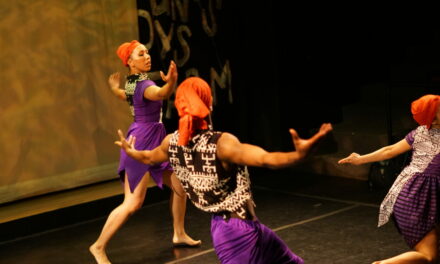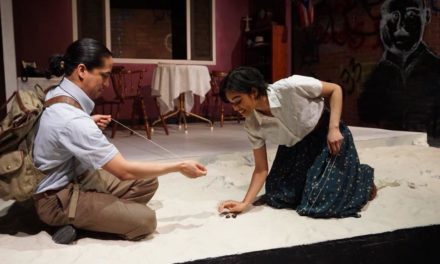Moby-Dick at the American Repertory Theater in Cambridge, MA
For those who are not familiar with the narrative construction of Herman Melville’s classic text, Moby-Dick, the novel encyclopedically touches on a great many things beyond the plot of one-legged Ahab’s obsession with the fearsome White Whale. There are chapters about how to cook a whale, criticism on the different pictorial representations of whales, exhaustively detailed anatomical descriptions of whales that attempt to textually render the beasts, while also making them more alien than ever. Chapter 42, titled “The Whiteness of The Whale,” is one such plotless chapter that wrestles with the emotional resonance of the idea of whiteness. Melville writes, “Though in many natural objects, whiteness refiningly enhances beauty, as if imparting some special virtue of its own…” and continues in his hallmark fashion to unfurl a list of historical grand examples of kings’ and empires’ regal uses of white—all in a single semicoloned sentence 468 words long (check it out for yourself). That’s not to say that whiteness is all beauty and purity in the novel. No, a few paragraphs later he writes, “This elusive quality it is, which causes the thought of whiteness, when divorced from more kindly associations, and coupled with any object terrible in itself, to heighten that terror to the furthest bounds.” Whiteness, he seems to be saying, can also make scary things even scarier. Enter Dave Malloy’s new adaptation of Moby-Dick (subtitled “A Musical Reckoning”) at the American Repertory Theater. Like the wooly, meticulous narrative of Melville, Malloy and director Rachel Chavkin have created a compelling theatrical equivalent—brimming with bombast, narrative diversions, and imagination. And like Melville, they too have an opinion on whiteness that is complex, sometimes nuanced, but mostly muddled in the churning tides of this mammoth adaptation. Which may be the point. But, like the novel, it’s hard to say what is the point.
Rachel Chavkin and Dave Malloy have ample experience in finding a theatrical voice for complicated novels. They brought the adventurous Natasha, Pierre, & the Great Comet of 1812—itself an adaptation of a sliver of Tolstoy’s War & Peace—to ART’s stage in December 2015. In Moby-Dick, the team again employs a variety of musical and narrative techniques to successfully maintain the spirit of the novel on the stage. Rather than eschew the philosophical, metaphysical, and exhaustive specificity of whaling in favor of a straight-forward narrative, Malloy embraces the multitudinous turns of the novel in novel ways. For example, Melville’s chapter on the types of whales (Chapter 32 “Cetology ”) becomes a funny song listing the whales while actors appear in costumes and with puppets representing the various sea creatures made from found and recycled objects. The chapter on cooking and eating whales (Chapter 65: The Whale as a Dish) becomes a vibrant and disgustingly hilarious vaudeville, full of fake blubber and spurting blood.
In finding a dramaturgical language for the novel, the creative team has also endeavored to ground the piece in today, touching on concepts and conversations around climate change/environmentalism and race. For example, at one point, harpooners Tashtego (Matt Kizer) and Daggoo (J.D. Mollison) discuss a “swirling vortex of plastic trash in the middle of the Pacific, twice the size of Texas.” This coupled with the puppets made of found or recycled materials, makes up the bulk of the production’s conversation around environmentalism. The idea is touched upon and then we move on to, say, a vaudeville about eating a whale.
Yet, this intentionally haphazard way of addressing socially relevant issues becomes altogether muddled and borderline dismissive in its dealing of race and identity. From the start, the production announces its color conscious casting when Ishmael (charmingly played by Manik Choksi) says that he wants to cast the Pequod “as the America I want to see.” The script dictates that the actor performing Ahab should be the only white man in the cast, requiring the rest of the cast of non-white actors to play both white and non-white characters. This is called “color conscious casting” and part of an important trend epitomized in the musical Hamilton. In this production, the casting isn’t necessarily troublesome but can be complicated. For example, there is a moment early in the musical that emphasizes that certain female performers of color—Starr Busby playing Starbuck, Kalyn West playing Stubb, and Anna Ishsida playing Flask—all mates on the ship, are, in fact, playing white men. A song titled “Knights and Squires” states, “Three noble white men stand on the backs of three noble non-white men”, meaning the three white mates are controlling the three harpooners of color Teshtego, Daggoo, and Queequeg (played by Andrew Cristi). For the audience, this asks them to extend the double vision that one already brings to the experience of theater: just as the audience can see a living, breathing actor saying lines on a gorgeously designed ship set (thanks to the imminently talented Mimi Lien) and simultaneously envision—in their second sight—the living, breathing character, a creaking vessel, and a plot unfolding, the creative team is asking for an expansion of the double vision—call it a triple vision—where the race and gender of the characters are performed by actors who are not of that specific race or gender.

Morgan Siobhan Green and the company of Moby-Dick. Photo: Maria Baranova
What dramaturgically makes this moment, and others in the musical, confusing is that the creative team seems to intentionally paint Ahab (grandly played by Tom Nelis) as uncaring and downright hostile to the people of color in his orbit. For example, when he points his gun at Starbuck, we feel the resonances of racist violence in America toward people of color, such as the October 2019 shooting of Atatiana Jefferson, a black woman, who was shot and killed in her own home in Fort Worth, Texas by a white police officer. But also, we remember that Starbuck performer Starr Busby is playing a white man, so what does that moment mean? Is the racism unimportant narratively? Similarly, when Captain Gardiner of the Rachel (wonderfully realized by Dawn L. Troupe) begs Ahab to find her/his child lost at sea, we see this moment as a woman of color begging a white man for help, but narratively that isn’t the case. Isn’t the character of Captain Gardiner white? And if so, does this moment have the racial resonance I am reading into it? Does it matter? The triple vision is nothing if not cloudy.
There are two moments that explicitly deal with whiteness in which the character’s race is narratively relevant. One is the death of Pip (played by Morgan Siobhan Green). Pip is a young cabin boy who has little to do in the first act and gets an extended tribute in the second act. He is described in the novel as, “at bottom very bright, with that pleasant, genial, jolly brightness peculiar to his tribe.” The fate of Pip, which is a huge moment in the musical, reads out of place in a work that barely features the character. In this way, Malloy is keeping true to the novel’s structure, which gives the same weight to this hapless character. Yet in doing so, it also shares in Melville’s paper-thin characterization of Pip and presents a borderline minstrel character—a theatrical form of which Melville would have been aware in 1851. Presumably, despite how close this work gets to a similar minstrel portrayal, we are aware of this as well in 2019/2020.
The second moment has stayed with me and has been a source of much conversation amongst POC friends who have also experienced this production. In the first act, a new character suddenly appears mid-way through the first whale hunt. Fedallah, played by Eric Berryman, a man of color, arrives by Ahab’s side, having been secreted on the ship as Ahab’s personal harpooning crew. After the hunt, the actor busts through the fourth wall in a long, stand-up-ish comedy routine where he decries the thinness of his character, mocks the creative team for faux-wokeness in its color-conscious casting, dismisses religion and America, and wishes for the annihilation of all human life. This seemingly scripted monologue, tonally unique to the rest of the play, presents the first uses of vulgarity in the play; Fedallah/Eric Berryman says “fuck” 16 times and “shit” 10 times in the one speech (almost the only cursing in the play until Daggoo later refers to “whale shit” and Tashtego says, “Fuck you” in response). In a play with so many moments that directly call back to Melville’s novel, this one is a whole-cloth creation by the team.
Not knowing the musical’s development process, it is difficult to say if this monologue is created by Malloy or if this is a moment that was devised by the performer, but, in the end, it doesn’t matter. Dave Malloy is credited as the composer, lyricist, book writer, and orchestrator of Moby-Dick and this moment reads as white, public self-flagellation voiced by a person of color. It also presents the complicated image of a black man playing the caricature of a “magical negro”—something in Melville’s creation—but an image that is couched in what is also read as a near caricature of a black stand-up comedian—an image that Malloy is credited as creating. I was having flashbacks of Young Jean-Lee’s complex play The Shipment, where a black comedian simply called “Stand-up Comedian” jokes about bestiality, bedding white, and black women, and the construction of race and racism. The routine is vulgar, aggressive, and spot-on. Its point is to make the majority white audience uncomfortable while saying some powerful and equally unsettling truths about being black in America. But what truly makes that moment in The Shipment work is that the rest of the play moves deeper into concepts of stereotyping, whiteness, and anti-blackness, buoying the base uncomfortable ideas in the stand-up routine. Moby-Dick, on the other hand, has the monologue end with the Fedallah/Eric Berryman stating that the next scene is supposed to be a cooking vaudeville show, which “should be fun.” And that is exactly what happens. And it is fun.
Dramatically, the monologue stands out as a moment that upends the rules of the musical: Fedallah breaks the fourth wall to speak, not sing, as the actor under the costume and in a decidedly coarser manner than anyone else in the show. It puts a bright spotlight on a moment and perspective that we never experience again, and I wondered: to what end? My concern with this moment is that, by passing it by and never addressing it again (spoiler: the character Fedallah goes on to magically portend the future and die), it lets whiteness off the hook. The self-flagellation provides the shot of catharsis needed to move on to the rest of the plot, which may work, but probably only for white folks. It is the nice thing about self-flagellation—you get to say when it stops; the scourge of racism continues for black and brown people because they don’t get to hold the whip. Again, see Atatiana Jefferson.

Manik Choksi in Moby-Dick. Photo: Evgenia Eliseeva
Clearly, like Melville’s book, Dave Malloy’s musical isn’t attempting to be prescriptive about what the titular whale metaphorically represents. It can be the power of whiteness. It can be God. It can be a million little things that pass us by in the musical. Race is an important part of this musical, but simply a part, and it too passes.
All of that to say, the many other parts of this show are fantastical, and I genuinely enjoyed the show. Rachel Chavkin is again masterly at moving large casts effectively and maintaining the energy of this show. Dave Malloy’s music is, as always, equal parts haunting and fun, and the cast is delightful. I hope the show has a long life and succeeds in, as Ishmael says at the show’s start, representing the America he wants to see. The America I want to see doesn’t and shouldn’t move on to the vaudeville cooking show after a black man or woman stands their ground—it stops, listens, and reckons with that truth for quite a while.
Moby-Dick runs at the American Repertory Theater in Cambridge, MA until January 12, 2020. Further information can be found here.
This post was written by the author in their personal capacity.The opinions expressed in this article are the author’s own and do not reflect the view of The Theatre Times, their staff or collaborators.
This post was written by James Montaño.
The views expressed here belong to the author and do not necessarily reflect our views and opinions.


















